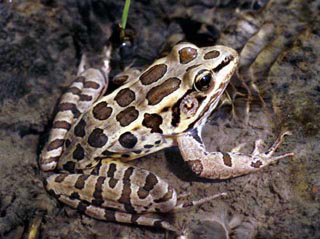The pickerel frog is common in Connecticut. Its skin is light brown with distinct, blocky, darker brown spots. Pickerel frogs are never green. Their bellies are white and the skin under their legs is an orangey-yellow. This is believed to be a warning of their unpalatability. Pickerel frogs can be 2 to 3 1/2 inches long.
Northern Leopard frogs and pickerel frogs are sometimes confused. A pickerel frog is never green. It has orange-yellow skin under its legs. Its spots are squarish. A leopard frog can be green or brown. The skin under its legs is white. Its spots are rounded.
As a defense, the skin of pickerel frogs produces a toxic substance that makes them unappealing or even fatal to some of their predators. The substance can be irritating to humans. Bullfrogs and green frogs are immune and will eat smaller pickerel frogs.
Pickerel frogs range through the eastern states of the US, except for the extreme southeast. They are very common throughout Connecticut. In New England they are 2cd in abundance to the green frog. Pickerel frogs prefer wet meadows and woods, marshes, streambeds, and shallow water surrounded by thick vegetation. Tadpoles live in the water until they reach maturity. Pickerel frogs are active during the warm season and hibernate for the winter underwater. They spend the winter buried in the mud on the bottom of a waterbody. They are nocturnal.
Adult pickerel frogs are insect-eaters. They hunt bugs by shooting out their sticky tongue to trap an insect and draw it back into their mouth. Their diet includes insects, snails, and earthworms. Immature pickerel frogs, tadpoles, feed on plant matter.
Pickerel frogs are one of the first frog species to emerge from hibernation in Connecticut, usually coming out in late winter or early spring. Mating season is in April and May and pickerel frogs seek out still, clear pools for breeding. Male pickerel frogs sing mating calls to attract a mate. A male grabs the female around her chest with his front legs and clings until she lays her eggs in the water. He deposits sperm on top of them. The female frogs produce about 2,000 to 3,000 eggs in a gelatinous mass. The mass is attached to plants below the water surface up to a depth of 4 feet. They are usually laid where vegetation is heavy. In a few days the eggs hatch into tadpoles. It can take 2 1/2 to 3 months for the tadpoles to absorb their tails, grow legs and develop lungs. Tadpoles live only in the water. Adult pickerel frogs can be in or out of water but stay where it is very moist.
Pickerel frogs are solitary, except when they congregate in breeding waters in the spring. The mating calls of the males sound like a rasp or "snore". They often sing underwater.
Frogs produce their calls by inflating part of their mouth lining under their throat with air through an opening in the bottom of their mouths. They then close off their mouths and nostrils and pump air between their lungs and this vocal sac over their vocal chords. The vocal sac of a calling frog is clearly visible as a bubble under his throat.
Neat Facts
Pickerel frogs are particularly sensitive to water quality. Their presence indicates the water is very clean.
Pickerel frogs cannot be kept in a captive habitat with other frogs as their skin secretions may be fatal to the other species.
